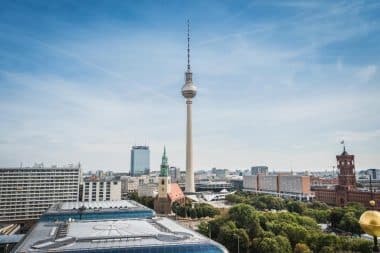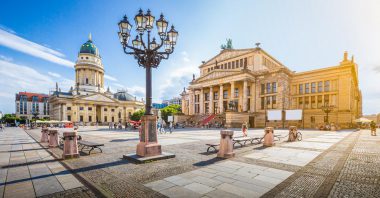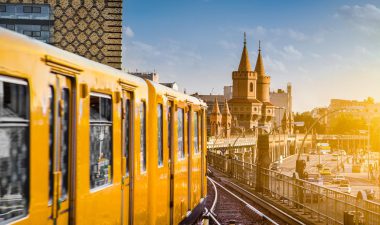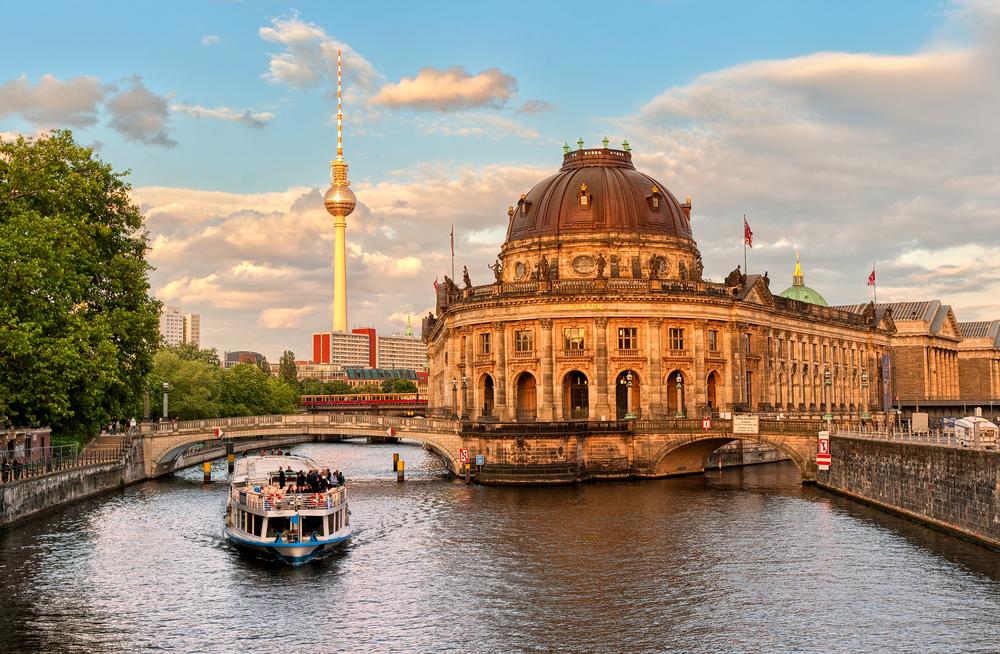Berlin is the capital of the Federal Republic of Germany and, with around 3.6 million inhabitants, the most populous and largest city in Germany. Like few metropolises, Berlin is rich in fascinating highlights and sights that bear witness to the eventful history of the city, but also of the country. The “Spreeathen” is certainly one of the most interesting tourist destinations in Germany and attracts several million tourists from Germany and abroad every year. Culture enthusiasts, partygoers and shopping fans will get their money’s worth on a city trip to Berlin, because Berlin has something to offer for everyone. Here are some of the city’s most interesting highlights and fascinating attractions.
The Brandenburg Gate – a symbolic landmark of the city

Once a memorial to the division of the city, today a symbol of German unity, the famous Brandenburg Gate in the Mitte district is a tourist magnet and a much-photographed motif. Numerous events take place around the gate throughout the year. One of the world’s largest events is the traditional New Year’s Eve party, to which hundreds of thousands from all over the world regularly flock to Berlin. Architecturally, the gate is one of the most impressive buildings of classicism. Built from 1788 to 1791 according to plans by Carl Gotthard Langhans the Elder, it is stylistically based on the Propylaea of the Athenian Acropolis. It formed the worthy conclusion of the boulevard Unter den Linden.
A must for those interested in culture – the Museum Island

Only about 1.5 kilometers from the Brandenburg Gate is the Museum Island. With its five museums, it forms one of the most important museum complexes in the world. The Altes Museum shows impressive exhibits of Greek art and cultural history. The Neues Museum is home to the Egyptian Museum and the world-famous bust of Queen Nefertiti. Highlights of the Pergamon Museum include the gigantic Pergamon Altar and the magnificent Ishtar Gate with its processional route. In the Alte Nationalgalerie , art lovers can admire works by Caspar David Friedrich and the French Impressionists. The Bode Museum includes the Museum of Byzantine Art, an important sculpture collection, and much more. For travelers who want to get a comprehensive overview of Berlin’s museum landscape, we recommend buying a museum pass. With the pass, they can then visit 30 museums and exhibitions of their choice free of charge and over several days.
All the splendour of the 19th century – the Berlin Cathedral

Very close to Museum Island is the imposing Berlin Cathedral on the Gendarmenmarkt. The listed building is the largest Protestant church in Germany and one of the most important dynastic burial sites in Europe. Numerous kings and electors have found their final resting place here. In addition to regular church services, concerts, important state acts and other events also take place in the Berlin Cathedral. The church, built between 1894 and 1905 in a mixture of Neo-Renaissance and Neo-Baroque styles, was severely damaged in the Second World War. Since its outer façade was rebuilt in a simplified form by 1984 and its interior in its original state by 2002, the cathedral has been one of the most important sights in the city.
A highlight for nature lovers – the Gardens of the World

What hardly anyone knows: Berlin is a “green” city and has around 2500 public parks and green spaces. Hardly any other European metropolis can keep up. A true gem within the many extensive parks are the Gardens of the World in the Marzahn district. The complex is a true oasis within the lively city. Here, visitors can experience and enjoy international garden art from different regions and epochs up close. Ten themed gardens, nine garden cabinets and many attractions invite visitors to take walks, contemplate and relax. Children like to use the numerous playgrounds or the playground. A varied gastronomic offer rounds off the extraordinary cultural and nature experience.
Shopping in Berlin at its best – Kurfürstendamm and KaDeWe

Kurfürstendamm is one of the most famous streets in the world and is still the number one shopping mile in Berlin. The beginnings of the Kurfürstendamm date back to the 16th century, when the road was laid out as a bridle path for the electors in the Grunewald. Today, the approximately four-kilometre-long boulevard stretches between Breitscheidplatz and Halensee, flanked by many exclusive designer boutiques, cafés and large department stores. One of the most famous and renowned among them is the Kaufhaus des Westens, or KaDeWe for short. With over 20,000 m², it offers a shopping experience in a class of its own. Of particular note is the gourmet floor on the sixth floor with its gigantic range of international delicacies.
Scene of recent German history – Checkpoint Charlie
Checkpoint Charlie was one of the three border points controlled by the Americans. During the division of Berlin, foreigners, GDR functionaries and employees of the FRG representation in the GDR were able to travel from East to West and vice versa. Like hardly any other place, you can experience contemporary history up close here. Although the watchtowers have disappeared, visitors can get an overview of the significance of this place through numerous facilities and in the Wall Museum. On around 1800 square meters, the museum documents various failed or successful escape attempts. In addition, it presents original escape objects, including a hot air balloon or a mini submarine.
For night owls and party-goers, the Friedrichsstadt-Palast
The Friedrichstadt-Palast is one of the most dazzling and largest revue theatres in the world. Spectacular, artfully staged shows, innovative lighting design, rousing songs and lavish glamour are trademarks of the Friedrichstadt-Palast. The ballet, consisting of 60 dancers, is an important part of the revues and inspires over 700,000 visitors from all over the world every year. Berghain in the Friedrichshain district attracts a younger audience in particular. The location is a techno club known far beyond Germany, which has often been the object of national and international reporting. Berghain is known for its strict bouncers and cool and long-lasting parties, which usually last from late in the evening until midday the following day.
Art in the open air – the East Side Gallery

Also in the Friedrichshain district is the famous East Side Gallery. After the fall of the Berlin Wall, 118 artists from 21 countries were assigned a section of the Wall. Over a length of 1316 meters, around 100 paintings were created, which give a good overview of the contemporary art scene. One of the most famous paintings is My God, Help Me Survive This Deadly Love by Dmitry Vrubel. It was based on a photo from 1979 and shows Leonid Brezhnev and Honecker kissing brotherly. Together with Checkpoint Charlie, the Brandenburg Gate and Bernauer Straße, the East Side Gallery is part of an overall concept for coming to terms with the division of Germany.
Not necessarily beautiful, but central and popular – Alexanderplatz

There are certainly more beautiful places in the world than Alexanderplatz. Nevertheless, with over 300,000 passers-by every day, the spacious area is the most visited area in Berlin and the fourth busiest square in Europe. By the way, this was already the case in the past. It is not for nothing that there are numerous paintings, books and films in which Alexanderplatz plays a leading role. The popularity of the location is certainly also due to its central location. From here, many of the city’s sights can be reached quickly and easily by public transport or on foot.
Sightseeing in an inexpensive way – the bus 100
If you want to see a lot of the German capital for little money, we recommend taking bus 100. It runs from Alexanderplatz to Bahnhof Zoo, passing many of the city’s most important sights along the way. With a day ticket or the Berlin Welcome Card , you can hop on and off at individual stops as you wish and organise your own city tour.
Our book tip: The other Berlin

192 pages, format 14.2 × 19.5 cm, 115 photos, softcover with flaps
Text: Oliver Kiesow, Photography: André Götzmann
A travel guide of the new generation: multimedia, scenery, versatile and on the trail of subcultures.
With insider tips on art and culture, architecture, hotspots, food, nightlife, queer life. On the road with insiders through the real Berlin – one of the most exciting metropolises in the world
Experience the casual and avant-garde hotspots of Berlin – the ideal destination for a city trip. From the uniquely international gastronomic scene to cool galleries and enchanting Waldbühne concerts to the incomparable nightlife in the city that never sleeps. Away from the tourist crowds, things get really interesting: where you meet bon vivants, subculture, queer life and the scene. Or where you only have to look around the right corners to immerse yourself in people’s everyday lives. Discover the real Berlin between currywurst and pub scene, culture, art of living and the incomparable history in the capital of reunification.
This travel guide was researched by an absolute insider and shows the metropolis of Berlin more authentically than ever before.
QR codes in the book always lead to video insider tips.
Facts about Berlin
- Berlin is the capital and largest city in Germany with a population of over 3.7 million people.
- The city has an eventful history, which was shaped by the Second World War and the division of the city into East and West Berlin. The Berlin Wall, which existed from 1961 to 1989, is a symbol of this division.
- Since reunification in 1990, Berlin has developed into an important political, cultural and economic centre of Europe.
- Berlin is known for its art and culture scene, which includes numerous museums, galleries, theaters, and music events. The city also has a vibrant street art scene.
- Berlin is an important location for startups and technology companies, and is often referred to as the “Silicon Valley” of Europe.
- The TV Tower at Alexanderplatz is the tallest building in Germany and one of Berlin’s most famous landmarks.
- Berlin is also known for its parks and green spaces, including Tiergarten, the city’s largest park, and Tempelhofer Feld, a former airport that is now used as a public park.
- The city is a major transport hub with an extensive network of suburban and underground lines, as well as buses and trams.
- Berlin is also an important venue for trade fairs, congresses and other major events. The International Consumer Electronics Exhibition (IFA) and the Berlinale, the largest public film festival in the world, take place in Berlin every year.
- Berlin cuisine is a mix of traditional German dishes and influences from other countries. Popular dishes include currywurst, Berliner Weisse (a sour wheat beer) and doner kebab, which was invented in Berlin.
Well-known museums in Berlin
- Pergamon Museum: The Pergamon Museum is one of the most famous museums in Berlin and houses antiquities from the Middle East, including the famous Pergamon Altarpiece.
- Neues Museum: The Neues Museum is known for its Egyptian artifacts, including the famous bust of Nefertiti.
- Alte Nationalgalerie: The Alte Nationalgalerie is an art museum that houses an extensive collection of works from German Romanticism, Impressionism, and the early 20th century.
- German Historical Museum: The German Historical Museum offers an insight into German history from early times to the present.
- Berlinische Galerie: The Berlinische Galerie is a museum of modern art and photography and focuses on artists associated with Berlin.
- Jewish Museum Berlin: The Jewish Museum Berlin offers an insight into Jewish history and culture in Germany.
- DDR Museum: The DDR Museum offers an insight into life in the former GDR.




